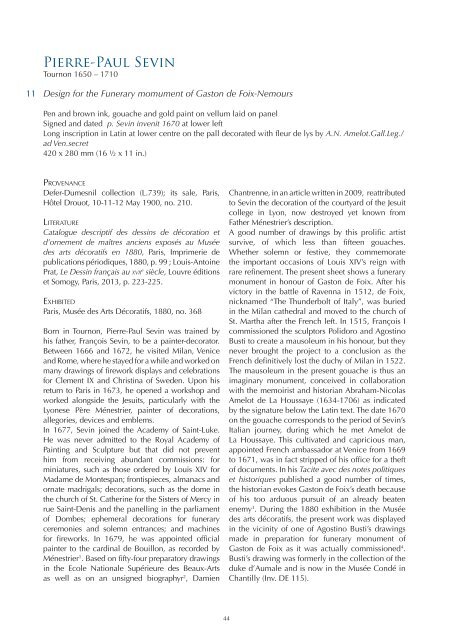XV - Works On Paper - Marty de Cambiaire (English)
You also want an ePaper? Increase the reach of your titles
YUMPU automatically turns print PDFs into web optimized ePapers that Google loves.
Pierre-Paul Sevin<br />
Tournon 1650 – 1710<br />
11<br />
Design for the Funerary momument of Gaston <strong>de</strong> Foix-Nemours<br />
Pen and brown ink, gouache and gold paint on vellum laid on panel<br />
Signed and dated p. Sevin invenit 1670 at lower left<br />
Long inscription in Latin at lower centre on the pall <strong>de</strong>corated with fleur <strong>de</strong> lys by A.N. Amelot.Gall.Leg./<br />
ad Ven.secret<br />
420 x 280 mm (16 ½ x 11 in.)<br />
PROVENANCE<br />
Defer-Dumesnil collection (L.739); its sale, Paris,<br />
Hôtel Drouot, 10-11-12 May 1900, no. 210.<br />
LITERATURE<br />
Catalogue <strong>de</strong>scriptif <strong>de</strong>s <strong>de</strong>ssins <strong>de</strong> décoration et<br />
d’ornement <strong>de</strong> maîtres anciens exposés au Musée<br />
<strong>de</strong>s arts décoratifs en 1880, Paris, Imprimerie <strong>de</strong><br />
publications périodiques, 1880, p. 99 ; Louis-Antoine<br />
Prat, Le Dessin français au <strong>XV</strong>II e siècle, Louvre éditions<br />
et Somogy, Paris, 2013, p. 223-225.<br />
EXHIBITED<br />
Paris, Musée <strong>de</strong>s Arts Décoratifs, 1880, no. 368<br />
Born in Tournon, Pierre-Paul Sevin was trained by<br />
his father, François Sevin, to be a painter-<strong>de</strong>corator.<br />
Between 1666 and 1672, he visited Milan, Venice<br />
and Rome, where he stayed for a while and worked on<br />
many drawings of firework displays and celebrations<br />
for Clement IX and Christina of Swe<strong>de</strong>n. Upon his<br />
return to Paris in 1673, he opened a workshop and<br />
worked alongsi<strong>de</strong> the Jesuits, particularly with the<br />
Lyonese Père Ménestrier, painter of <strong>de</strong>corations,<br />
allegories, <strong>de</strong>vices and emblems.<br />
In 1677, Sevin joined the Aca<strong>de</strong>my of Saint-Luke.<br />
He was never admitted to the Royal Aca<strong>de</strong>my of<br />
Painting and Sculpture but that did not prevent<br />
him from receiving abundant commissions: for<br />
miniatures, such as those or<strong>de</strong>red by Louis XIV for<br />
Madame <strong>de</strong> Montespan; frontispieces, almanacs and<br />
ornate madrigals; <strong>de</strong>corations, such as the dome in<br />
the church of St. Catherine for the Sisters of Mercy in<br />
rue Saint-Denis and the panelling in the parliament<br />
of Dombes; ephemeral <strong>de</strong>corations for funerary<br />
ceremonies and solemn entrances; and machines<br />
for fireworks. In 1679, he was appointed official<br />
painter to the cardinal <strong>de</strong> Bouillon, as recor<strong>de</strong>d by<br />
Ménestrier 1 . Based on fifty-four preparatory drawings<br />
in the Ecole Nationale Supérieure <strong>de</strong>s Beaux-Arts<br />
as well as on an unsigned biographyr 2 , Damien<br />
Chantrenne, in an article written in 2009, reattributed<br />
to Sevin the <strong>de</strong>coration of the courtyard of the Jesuit<br />
college in Lyon, now <strong>de</strong>stroyed yet known from<br />
Father Ménestrier’s <strong>de</strong>scription.<br />
A good number of drawings by this prolific artist<br />
survive, of which less than fifteen gouaches.<br />
Whether solemn or festive, they commemorate<br />
the important occasions of Louis XIV’s reign with<br />
rare refinement. The present sheet shows a funerary<br />
monument in honour of Gaston <strong>de</strong> Foix. After his<br />
victory in the battle of Ravenna in 1512, <strong>de</strong> Foix,<br />
nicknamed “The Thun<strong>de</strong>rbolt of Italy”, was buried<br />
in the Milan cathedral and moved to the church of<br />
St. Martha after the French left. In 1515, François I<br />
commissioned the sculptors Polidoro and Agostino<br />
Busti to create a mausoleum in his honour, but they<br />
never brought the project to a conclusion as the<br />
French <strong>de</strong>finitively lost the duchy of Milan in 1522.<br />
The mausoleum in the present gouache is thus an<br />
imaginary monument, conceived in collaboration<br />
with the memoirist and historian Abraham-Nicolas<br />
Amelot <strong>de</strong> La Houssaye (1634-1706) as indicated<br />
by the signature below the Latin text. The date 1670<br />
on the gouache corresponds to the period of Sevin’s<br />
Italian journey, during which he met Amelot <strong>de</strong><br />
La Houssaye. This cultivated and capricious man,<br />
appointed French ambassador at Venice from 1669<br />
to 1671, was in fact stripped of his office for a theft<br />
of documents. In his Tacite avec <strong>de</strong>s notes politiques<br />
et historiques published a good number of times,<br />
the historian evokes Gaston <strong>de</strong> Foix’s <strong>de</strong>ath because<br />
of his too arduous pursuit of an already beaten<br />
enemy 3 . During the 1880 exhibition in the Musée<br />
<strong>de</strong>s arts décoratifs, the present work was displayed<br />
in the vicinity of one of Agostino Busti’s drawings<br />
ma<strong>de</strong> in preparation for funerary monument of<br />
Gaston <strong>de</strong> Foix as it was actually commissioned 4 .<br />
Busti’s drawing was formerly in the collection of the<br />
duke d’Aumale and is now in the Musée Condé in<br />
Chantilly (Inv. DE 115).<br />
44
















